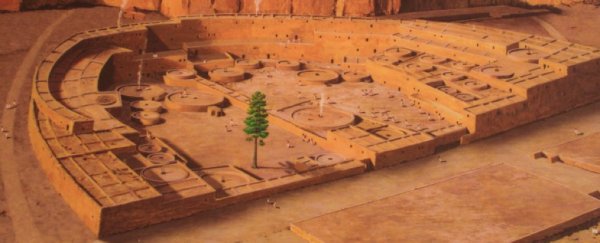For hundreds of years, it lay undisturbed. Then, almost a century ago, archaeologists discovered it: a single pine tree, buried amidst the grandest of all the great houses of Chaco culture.
Pueblo Bonito (Beautiful Town), in New Mexico's Chaco Canyon, has long been considered the cultural hub of the Ancestral Puebloans who dwelled here for centuries, founding the site over 1,000 years ago, before abandoning it about 1126 CE.
When they departed, the villagers left behind a wondrous legacy of massive structures that once stood up to five storeys high, filled with hundreds of rooms, and cultural artefacts, including pottery, musical instruments, and tools for use in ancient rituals.
They also left something else behind: the lone log of a ponderosa pine (Pinus ponderosa), measuring 6 metres (20 ft) long, which archaeologists couldn't make sense of when they stumbled upon it during a dig in 1924.
 A modern reconstruction of what Pueblo Bonito might have looked like. (National Park Service)
A modern reconstruction of what Pueblo Bonito might have looked like. (National Park Service)
"At the south end of the West Court we unexpectedly discovered the remains of a large pine that had stood there, alive and green, when Pueblo Bonito was inhabited," the researchers later wrote of the find.
"Its decayed trunk lay on the last utilised pavement, and its great, snaglike roots preclude the possibility of its ever having been moved."
This vivid description – and the assumptions inherent within it – have ever since resonated throughout archaeological and anthropological literature, creating a rich legend around this seemingly unique pine, alone in the otherwise treeless environment of Pueblo Bonito.
Within these narratives, the pine has been characterised as a 'tree of life' or 'world tree' imbued with cosmological significance, notions of birth symbolism, or other mysterious speculations about its purpose (including that it might be a giant sun-dial).
"It is apt that the world tree should be viewed as the centre of the Universe, for it is relative to this axis that sacred time, the heavenly rhythm reflected by the play of light and shadow, becomes the geometry and symmetry of a sacred place," one study observed.
In rebuttal, a new study led by tree-ring expert Christopher Guiterman from the University of Arizona suggests some of the more fanciful ideas around this majestic pine "have not been rigorously tested", and offers an alternative explanation for the tree's backstory.
"Based on converging lines of evidence – documentary records, strontium isotopes, and tree-ring provenance testing – we present a new origin for the Plaza Tree," the authors write in their paper.
"It did not grow in Pueblo Bonito or even nearby in Chaco Canyon."
 Cross-section of a sample taken from the Pueblo Bonito plaza tree. (Christopher Guiterman)
Cross-section of a sample taken from the Pueblo Bonito plaza tree. (Christopher Guiterman)
According to the evidence Guiterman's team found, including comparisons of tree rings in a sample from the Plaza Tree with samples from trees in nearby regions, the famous pine did not ever lay its roots in Pueblo Bonito.
"We have this incredible database from 100-plus years of tree-ring science," says Guiterman.
"Trees from the San Juan Mountains, the Jemez Mountains or the Chuska Mountains – they all have their own kind of flavour, their own peculiar signature."
By analysing those signatures, along with over evidence to date the tree, the team concludes that the town's majestic pine lived for about 250 years (until about the early 1100s) in the Chuska Mountains, about 50 kilometres (30 miles) west of Chaco Canyon.
At some point around then – which is hard to know for sure, since the outer layers of the log were lost to decay – the tree died, either from natural causes or from being felled. Then, it was transported to Pueblo Bonito, where the team says it might have been intended for firewood, used as a bench, or erected as a standing pole.
 Pueblo Bonito as it is today. (Thomas Swetnam)
Pueblo Bonito as it is today. (Thomas Swetnam)
"It could have toppled or been left standing to eventually collapse onto the plaza," the researchers explain. "Finally, it was buried by windblown sand over the centuries."
While not entirely discounting the possibility that the tree might have served as a gnomon (the part of a sundial that casts a shadow), the team says their "mundane" explanations are far more likely than it being a symbol of 'birth' or 'life' in Pueblo Bonito, given we now know it was a dead, imported tree, and not the lone remnant of a mysterious Chaco forest for which no other evidence survives.
Exactly why these ancient villagers felt the need to transport the giant log such a great distance remains a compelling question, but the team is confident the rest of this mysterious legend can finally be put to rest.
"If a marker of anything, the Plaza Tree of Pueblo Bonito reflects the final fluorescence or decline of Pueblo Bonito," the team says, "rather than its beginning."
The findings are reported in American Antiquity.
